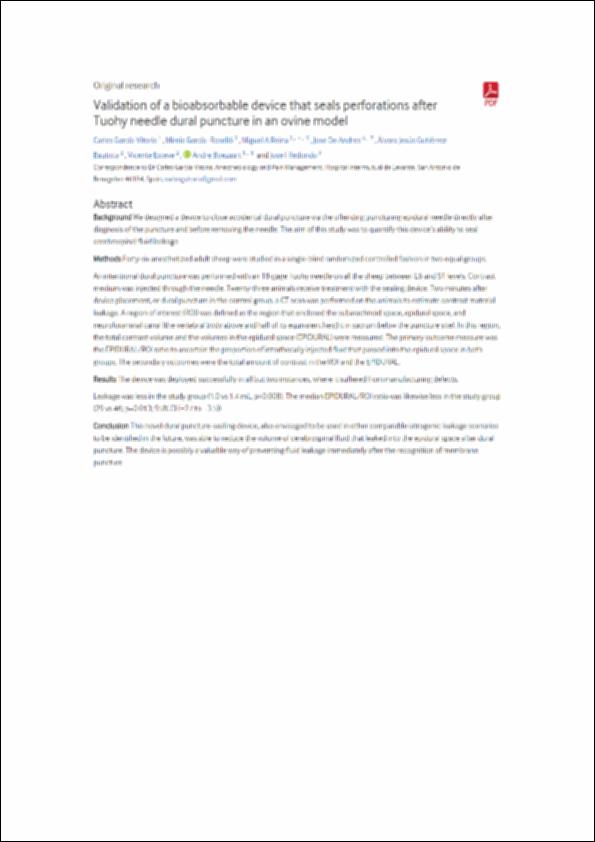Please use this identifier to cite or link to this item:
http://hdl.handle.net/10637/15921Validation of a bioabsorbable device that seals perforations after Tuohy needle dural puncture in an ovine model
| Title: | Validation of a bioabsorbable device that seals perforations after Tuohy needle dural puncture in an ovine model |
| Authors : | García Vitoria, Carles García Roselló, Mireia Reina Perticone, Miguel Ángel Andrés, José de Gutiérrez Bautista, Álvaro Jesús Esteve, Vicente Boezaart, Andre Redondo García, José Ignacio |
| Keywords: | Analgesia; Spinal cord; Médula espinal; Biomedical materials; Materiales biomédicos; Injections; Inyecciones; Peridural Anesthesia; Anestesia epidural |
| Publisher: | BMJ American Society of Regional Anesthesia & Pain Medicine |
| Citation: | García-Vitoria, C., García-Roselló, M., Reina, M.A., Andres, J. de, Gutiérrez-Bautista, Á.J., Esteve, V., Boezaart, A. & Redondo, J.I. (2021). Validation of a bioabsorbable device that seals perforations after Tuohy needle dural puncture in an ovine model. Regional Anesthesia and Pain Medicine, vol. 46, i. 5 (may.), pp. 389–396. DOI: https://doi.org/10.1136/rapm-2020-102225 |
| Abstract: | Background: We designed a device to close accidental dural puncture via the offending puncturing epidural needle directly after diagnosis of the puncture and before removing the needle. The aim of this study was to quantify this device's ability to seal cerebrospinal fluid leakage. Methods: Forty-six anesthetized adult sheep were studied in a single-blind randomized controlled fashion in two equal groups.An intentional dural puncture was performed with an 18-gage Tuohy needle on all the sheep between L6 and S1 levels. Contrast medium was injected through the needle. Twenty-three animals receive treatment with the sealing device. Two minutes after device placement, or dural puncture in the control group, a CT scan was performed on the animals to estimate contrast material leakage. A region of interest (ROI) was defined as the region that enclosed the subarachnoid space, epidural space, and neuroforaminal canal (the vertebral body above and half of its equivalent height in sacrum below the puncture site). In this region, the total contrast volume and the volumes in the epidural space (EPIDURAL) were measured. The primary outcome measure was the EPIDURAL/ROI ratio to ascertain the proportion of intrathecally injected fluid that passed into the epidural space in both groups. The secondary outcomes were the total amount of contrast in the ROI and the EPIDURAL. Results: The device was deployed successfully in all but two instances, where it suffered from manufacturing defects.Leakage was less in the study group (1.0 vs 1.4 mL, p=0.008). The median EPIDURAL/ROI ratio was likewise less in the study group (29 vs 46; p=0.013; 95% CI (-27 to -3.5)). Conclusion: This novel dural puncture-sealing device, also envisaged to be used in other comparable iatrogenic leakage scenarios to be identified in the future, was able to reduce the volume of cerebrospinal fluid that leaked into the epidural space after dural puncture. The device is possibly a valuable way of preventing fluid leakage immediately after the recognition of membrane puncture. |
| Description: | This is the peer reviewed version of the following article: García-Vitoria, C., García-Roselló, M., Reina, M.A., Andres, J. de, Gutiérrez-Bautista, Á.J., Esteve, V., Boezaart, A. & Redondo, J.I. (2021). Validation of a bioabsorbable device that seals perforations after Tuohy needle dural puncture in an ovine model. Regional Anesthesia and Pain Medicine, vol. 46, i. 5 (may.), pp. 389–396, which has been published in final form at https://doi.org/10.1136/rapm-2020-102225. Este es el post-print del siguiente artículo: García-Vitoria, C., García-Roselló, M., Reina, M.A., Andres, J. de, Gutiérrez-Bautista, Á.J., Esteve, V., Boezaart, A. & Redondo, J.I. (2021). Validation of a bioabsorbable device that seals perforations after Tuohy needle dural puncture in an ovine model. Regional Anesthesia and Pain Medicine, vol. 46, i. 5 (may.), pp. 389–396, que se ha publicado de forma definitiva en https://doi.org/10.1136/rapm-2020-102225 |
| URI: | http://hdl.handle.net/10637/15921 |
| Rights : | http://creativecommons.org/licenses/by-nc-nd/4.0/deed.es |
| ISSN: | 1098-7339 1532-8651 (Electrónico) |
| Issue Date: | May-2021 |
| Center : | Universidad Cardenal Herrera-CEU |
| Appears in Collections: | Dpto. Medicina y Cirugía Animal |
Items in DSpace are protected by copyright, with all rights reserved, unless otherwise indicated.


